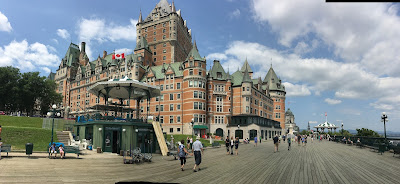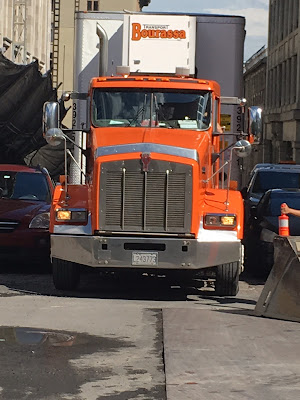 |
| Miss Jazz, S/V Blue Pearl, and Midas Touch |
We pushed off from the Wall at 9:06 on Sunday, July 24 and followed Miss Jazz to her home, tying up just before noon. With
a very long, heavy-duty shore power cord, we were able to connect Midas Touch to shore power, not the 30 amps we would have at a marina, but enough to power the refrigerator, lights, and a fan. No air-conditioning needed! Summers in Ontario are delightful, especially when there's a pleasant breeze off the water in Parc national de Plaisance. The dock, about 100 feet from the house, holds Miss Jazz on the left, rafted to son Patrick's sailboat La Perle Bleue, and Midas Touch on the right. In winter, the bay freezes over, so Francis and Hélène can drive across the bay to town. It's a much shorter trip.
 |
| Interior of Francis & Hélène's home |
 |
| Midas had lots of room to play during our stay |
Francis also introduced us to a wonderful liqueur, Genepe, which we haven't been able to find in the States.
Francis and Hélène's son Patrick, who was a firefighter, their (now former) daughter-in-law Audrey, and beautiful granddaughter Zoe joined us for one of our meals, and we immediately felt we'd been friends for life. Patrick and family live in a house he and Francis built, between Francis and Hélène's house and the road. The homes are near the small Quebec town of Papineauville, where we shopped for groceries and saw both a McDonald's and a Tim Horton''s. We love Tim Horton's and wish the company would expand to Georgia.
 |
| Zoe - a charmer if ever there was one |
http://en,wikipedia.org/wikie/Ch%C3%AZteau_Monebello)
Our home is in North Georgia, known - among other things, like the first U.S. Gold Rush and moonshining - for its beautiful waterfalls. La Chute, a short drive from Francis and Hélène's home, is just as beautiful.

Mike told mon ami Francis, “You either get the Canadian adoption papers or kick us out.” We couldn't stay forever, and when we left on Saturday, July 30. we followed Francis and Hélène in Miss Jazz about halfway to an anchorage Francis recommended. They had brought lunch, and after a final feast, we waved farewell to people we consider lifelong friends. Francis had told us about a great place to anchor for the night just east of Ottawa and explained how to approach the park between the two markers. Petrie Island, another Parcs Canada location, is on the Ontario side of the Ottawa River, but we could see Quebec on the north side.
https://www.petrieisland.org/beaches
Francis had told us to watch for buoys to warn of shallow areas, and sure enough, we found one and managed to ding our prop. That didn't stop us from going ashore to give Midas a "get busy" break and to check out the park, which was full of boaters and picnickers on a sunny Saturday afternoon. While there, Mike tightened the packing gland that keeps water from entering the boat around the shaft and worked on a switch that ties the transmission to the starter.
We spent the evening watching people enjoy the beach, the park, a parasailer, and a beautiful sunset on the river, with a glass of Smoky Bay, our favorite Canadian wine, to top off a glorious day.



After taking Midas ashore Sunday morning, we raised the dinghy and pulled the anchor at 9:15, heading to Ottawa and the Chain of Locks, entry point for the Rideau Canal.
(http://www.rideau-info.com/canal/history/locks/h01-08-ottawa.html)
Because we had a bent prop blade, we had to keep the RPMs down. It was a short, slow trip to Ottawa and the eight locks in the Chain, which lifts boats up into the northern end of the Rideau Canal system. You can see the Rideau Falls and Prince of Wales Falls in the photo.
 We waited a few hours for our turn to lock up. Sunday was a beautiful day and we were just one boat among dozens at the base of the Chain. Along with about seven other boats, we entered the bottom lock at 3:42 PM, and by that time it was a very warm day. While we waited our turn at the bottom of the lock, with another boat rafted to our port side, Mike and Midas explored the area, which was crowded with on-lookers who wanted to watch boats go through. The lock tenders select from the waiting boats and determine which will enter, in what order, and to which side of the lock the boats will tie up. Once you start up (or down), you must complete all eight locks, leaving the first when it's been filled and moving slowly into the next, where one person (Marian in our case) uses a boat hook to snag a strong cable attached at the top and bottom of each lock wall, then pulls the boat forward to our assigned location. The second person (Captain Mike) grabs the rear cable. Then we thread our lock lines around the cable, Marian cuts the engine, then we hold on to our line as the lock fills and lifts us to the next chamber. We wore gloves to make it easier to manage the lines and cables and to avoid touching the slimy lock walls.
We waited a few hours for our turn to lock up. Sunday was a beautiful day and we were just one boat among dozens at the base of the Chain. Along with about seven other boats, we entered the bottom lock at 3:42 PM, and by that time it was a very warm day. While we waited our turn at the bottom of the lock, with another boat rafted to our port side, Mike and Midas explored the area, which was crowded with on-lookers who wanted to watch boats go through. The lock tenders select from the waiting boats and determine which will enter, in what order, and to which side of the lock the boats will tie up. Once you start up (or down), you must complete all eight locks, leaving the first when it's been filled and moving slowly into the next, where one person (Marian in our case) uses a boat hook to snag a strong cable attached at the top and bottom of each lock wall, then pulls the boat forward to our assigned location. The second person (Captain Mike) grabs the rear cable. Then we thread our lock lines around the cable, Marian cuts the engine, then we hold on to our line as the lock fills and lifts us to the next chamber. We wore gloves to make it easier to manage the lines and cables and to avoid touching the slimy lock walls.  |
| Boats waiting at the bottom of the lock. |
We were very relieved when we exited the final lock, about 5:30, then found an open spot with a shore power pedestal along the wall and tied up at 5:45. Our Parcs Canada pass included dockage at any lock wall along the Rideau Canal and the Trent-Severn Waterway, as well as entry to any of the Parks Canada national parks. We had to pay $29.40C for shore power - a bargain. Confederation Park was near our spot, and across the street, a Westin Hotel, where we strolled in to use their restrooms instead of filling the holding tank on the boat. We stayed on the wall for three nights and explored Ottawa on foot and by Uber. That will be the next chapter.
 |
| One of the statues in Confederation Park, near our spot on the lock wall. Mike couldn't resist putting his new CIA hat on top of his head. |
 |
| Looking south along the Rideau from the bow. in the winter the canal is the longest skating rink in the world. |
 |
| The other side of the canal, with Canada's Parliament Buildings in the background. |













































